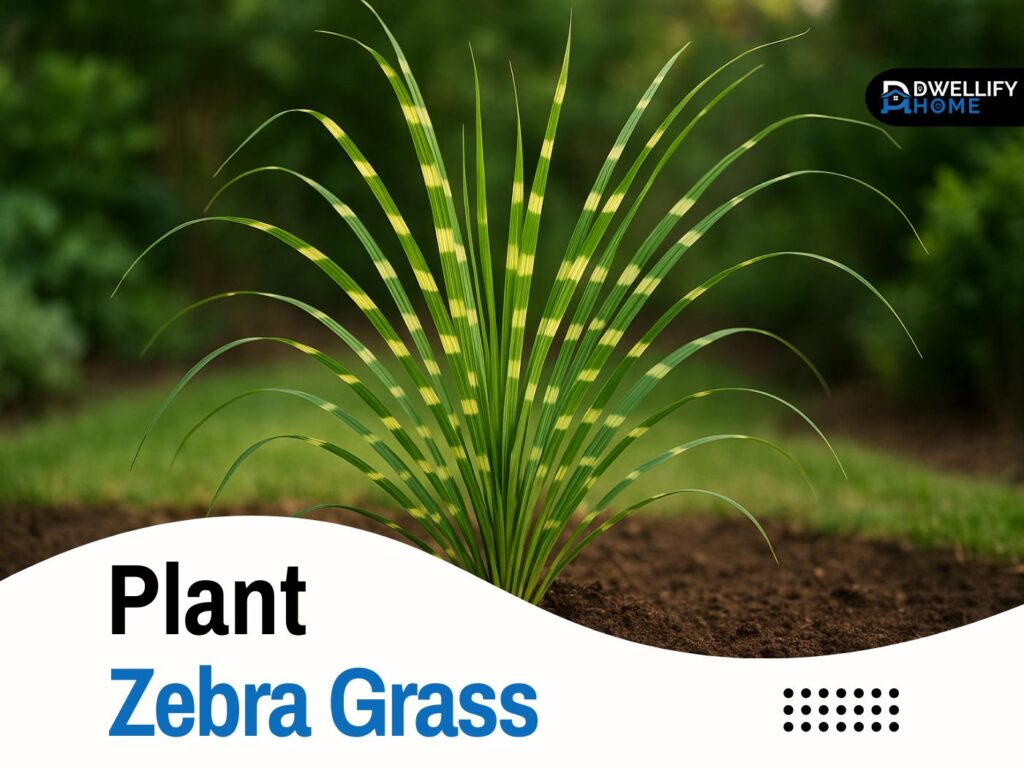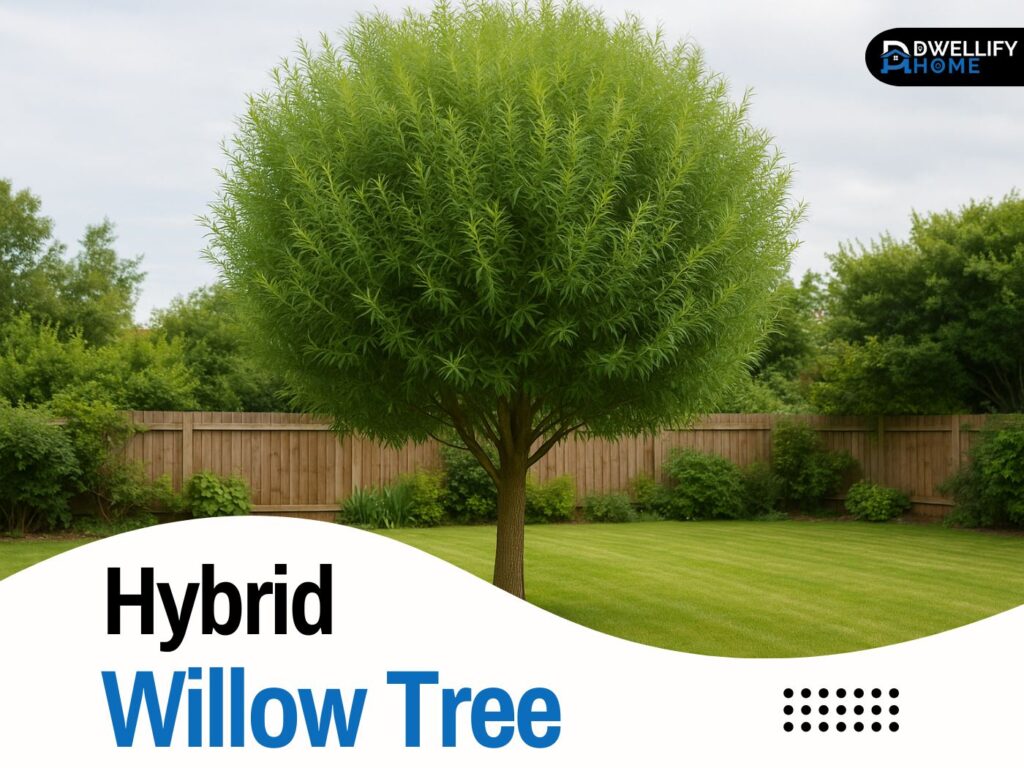If you’ve ever seen a plant that looks like it’s wearing green and yellow stripes, chances are it was zebra grass. This tall, graceful ornamental grass is a favorite among gardeners because it’s easy to grow and adds movement and texture to any yard. The best part? It looks beautiful all year round, even when other plants are taking a break.
In this guide, I’ll walk you through everything you need to know about how to plant zebra grass, care for it, and keep it looking its best. Whether you’re new to gardening or just want to add something unique to your landscape, you’ll find plenty of practical advice and real experience-based tips here.
Snippet-Ready Definition:
Planting zebra grass adds texture and color to your garden with its bold yellow-green stripes. It’s a low-maintenance ornamental grass that grows tall, moves gracefully in the wind, and returns each year.
Mission Statement
At Dwellify Home, our mission is to empower homeowners and garden enthusiasts with practical, expert-backed guides that make home living more beautiful and sustainable. From home design to garden care, we help you make confident, informed decisions — one project at a time.
Zebra Grass Basics: Getting to Know This Unique Plant
Zebra grass, scientifically known as Miscanthus sinensis ‘Zebrinus’, is a type of ornamental grass that stands out for its golden horizontal stripes. It grows in dense clumps that move beautifully with the breeze. The plant is native to East Asia and is often used for adding structure and height in gardens.
Mature zebra grass can reach around 5 to 8 feet tall, with a spread of about 4 to 6 feet. It grows upright and forms graceful, fountain-like clumps. There’s also a smaller version called Little Zebra Grass, which is great for smaller gardens or even large containers.
This grass is hardy and adaptable, which makes it a great choice for beginners. It thrives in full sun and can tolerate a range of soil conditions, as long as it’s well-drained. Once it’s established, it becomes quite low-maintenance.
Is Zebra Grass Invasive?
Here’s the thing — zebra grass spreads through clumps, not runners, so it’s generally considered non-invasive in most areas. However, in some warmer climates, it can reseed and spread more than you might expect.
To keep it under control, remove the seed heads before they mature, or divide your clumps every few years. If you’re planting near natural waterways, check local regulations, since some regions are cautious about fast-spreading ornamental grasses.
In my experience, zebra grass stays tidy if you give it the space it needs and maintain it once a year. It’s more of a well-behaved guest than a wild invader.
When and How to Plant Zebra Grass
The best time to plant zebra grass is in spring or early fall. During these seasons, the soil is warm enough to encourage root growth, and the plant can settle before the heat of summer or the chill of winter.
Choose a sunny spot because zebra grass loves light. It can handle a little shade, but the stripes will be less bright if it doesn’t get enough sun. As for soil, zebra grass prefers moist, fertile soil that drains well. Avoid heavy clay that stays soggy, as that can cause root rot.
When planting, dig a hole twice as wide as the root ball and just as deep. Set the plant in, backfill the soil, and water thoroughly. If you’re planting multiple clumps, space them about 3 to 5 feet apart. This gives each one room to expand without crowding.
Growing Zebra Grass in Pots and Indoors
Can you plant zebra grass in a pot? Absolutely! I’ve grown zebra grass in large containers on my patio, and it looks stunning swaying in the breeze. Just pick a pot that’s at least 18 inches wide and deep, and make sure it has good drainage holes.
Use a well-draining potting mix and water regularly, especially during hot weather. Container-grown zebra grass will need more frequent watering than garden-grown plants since pots dry out faster.
Some gardeners even keep zebra grass indoors near sunny windows. It’s not common, but if you can give it enough light and space, it can be a bold, decorative indoor plant for a sunroom or conservatory.
Zebra Grass Seeds and Propagation
If you’d rather start from seeds, zebra grass seeds are available from many nurseries and online shops. However, growing from seed takes patience. The germination rate can be low, and it may take a full season or two before you see mature clumps.
The easier way is by dividing mature plants. Every few years, dig up your zebra grass in spring, split the clump with a sharp spade or saw, and replant the divisions. This keeps the plant healthy, prevents overcrowding, and gives you free plants to use elsewhere.
It’s also the best way to refresh the center of an old clump, which can sometimes die out after a few years.
Watering, Feeding, and Ongoing Care
Once zebra grass is established, it’s surprisingly tough. Water it deeply every week during the first growing season to help it build strong roots. After that, it usually only needs extra watering during long dry spells.
Adding mulch around the base helps keep moisture in and weeds out. Avoid overwatering, especially in heavy soils. This plant likes moisture but hates soggy feet.
Fertilizer isn’t a must, but if you want lush growth, use a balanced slow-release fertilizer in spring. Too much nitrogen can make the plant flop over, so go easy.
When to Cut Back Zebra Grass
Zebra grass is a perennial, so it goes dormant in winter. The leaves turn golden brown but remain upright, adding winter interest to your garden.
Don’t rush to cut it back in the fall. The dried plumes look beautiful with frost or snow, and they provide shelter for small birds. The best time to cut it back is late winter or early spring, before new shoots appear. Cut it to about 6 to 10 inches from the ground using sharp shears or electric trimmers.
Here’s a tip: tie the leaves together with a rope before cutting. It makes cleanup a whole lot easier!
Dealing with Spread and Overgrowth
Does zebra grass spread? It does, but slowly. The plant grows from the base, expanding its clump each year. If you notice it’s getting too large or floppy, divide it in spring.
To keep it from taking over smaller areas, you can plant it inside a root barrier or large plastic tub sunk into the ground. That way, the roots stay where you want them.
Removing seed heads in fall also prevents self-seeding, especially if you live in a warm region.
Landscape Design Ideas with Zebra Grass
Zebra grass fits almost anywhere. You can use it as:
- A tall background plant in borders
- A living screen along fences or patios
- A focal point near ponds or walkways
- A centerpiece in a large pot on your deck
It looks great when paired with plants like coneflowers, black-eyed Susans, or lavender. These combinations create contrast and attract butterflies.
One of my favorite tricks is to plant zebra grass behind shorter flowers. When the wind blows, the grass gently moves while the blooms stay steady — it adds life and motion to the garden.
Varieties Worth Trying
The traditional Zebrinus variety is the most common, but there are others worth exploring:
- Little Zebra: A compact version that grows about 3 to 4 feet tall. Perfect for small gardens or containers.
- Strictus: Has more upright growth and stronger striping.
- Gold Bar: Very bright stripes, shorter height — great for decorative borders.
Each type has its charm, but if you’re new, start with Zebrinus. It’s reliable, hardy, and very forgiving.
Common Problems and Solutions
Sometimes zebra grass flops or looks thin. Usually, that’s because it’s too shaded or overfertilized. Move it to a sunnier spot or cut back on fertilizer.
Another common issue is the center of the clump dying out. That’s a sign it needs dividing. Dig it up, discard the dead center, and replant the healthy outer parts.
If the leaves turn yellow, it could be a sign of too much water or poor drainage. Improve the soil or move the plant to higher ground.
As for pests, zebra grass rarely has serious problems. Occasionally, you might spot aphids or rust, but these are easy to control with natural sprays or pruning.
Buying Zebra Grass for Your Garden
You can find zebra grass for sale at most local nurseries or online plant stores. Look for plants with strong green leaves and no signs of browning or rot.
Seedlings and plugs are cheaper but take longer to grow; mature plants establish faster and give instant impact. Either way, buy from reputable sellers so you get the true striped variety, not a plain miscanthus type.
Expert Tips from Experience
After growing zebra grass for years, here are a few tricks that always help:
- Don’t overwater — it’s easier to revive a dry plant than one that’s drowned.
- Divide every 3 to 4 years to keep it full and fresh.
- In windy areas, tie or stake the clumps to keep them upright.
- Leave the dry foliage through winter — it’s gorgeous and protects new shoots.
- Avoid planting it too close to walkways; the long leaves can arch into paths.
These small steps make a big difference in how neat and healthy your zebra grass looks year-round.
Step-by-Step Guide: How to Plant Zebra Grass
| Step | What to Do | Why It Matters | ||
| 1. Choose the Right Time | Plant zebra grass in spring or early fall. | These seasons help roots settle before temperature extremes. | ||
| 2. Pick a Sunny Spot | Select a location with full sun and well-draining soil. | Sunlight enhances striping and strong growth. | ||
| 3. Prepare the Soil | Loosen soil 12 inches deep, add compost for nutrients. | Enriches the ground for healthy roots. | ||
| 4. Space the Plants | Keep 3–5 feet between each clump. | Prevents overcrowding as the plant spreads. | ||
| 5. Water & Mulch | Water deeply once a week, then mulch around base. | Locks in moisture and reduces weeds. | ||
| 6. Maintain & Cut Back | Cut to 6–10 inches in late winter or early spring. | Keeps new shoots healthy and prevents flopping. |
Quick Bullet List: Key Zebra Grass Facts
- Botanical name: Miscanthus sinensis ‘Zebrinus’
- Mature height: 5–8 feet (Little Zebra: 3–4 feet)
- Sun exposure: Full sun to light shade
- Soil preference: Moist, well-drained
- Best time to plant: Spring or early fall
- Invasive risk: Low when maintained properly
- Propagation: Division or seeds
FAQs About Planting Zebra Grass
When should you plant zebra grass?
The best time to plant zebra grass is in spring or early fall, when temperatures are mild and the soil is warm enough to encourage strong root growth.
How invasive is zebra grass?
Zebra grass is not aggressively invasive. It grows in clumps, not runners. However, in warm climates, it can reseed. To control spread, divide clumps every few years and remove seed heads before they mature.
Does zebra grass come back every year?
Yes, zebra grass is a perennial plant. It dies back in winter but returns each spring with fresh green and yellow-striped leaves.
Can I grow zebra grass from seed?
You can, but it’s slow. Zebra grass seeds take a long time to germinate and mature. Dividing existing clumps is a faster and more reliable way to grow new plants.
How far apart should I plant zebra grass?
Space zebra grass 3 to 5 feet apart to allow enough room for each clump to expand without crowding.
Conclusion
Planting zebra grass is one of the easiest ways to bring elegance and movement to your garden. It’s low-maintenance, beautiful in every season, and forgiving even if you’re not an expert gardener.
Start with a sunny spot, plant it at the right time, and give it space to shine. Once it settles, zebra grass will reward you with years of stunning color and texture.
So go ahead — plant zebra grass and watch your garden transform into a place that feels alive, peaceful, and full of charm.
Disclaimer
The information provided in this article on planting zebra grass is for educational and informational purposes only. While every effort has been made to ensure accuracy, readers should always consider local climate conditions and consult regional gardening experts or extension offices before planting. Dwellify Home assumes no liability for any plant performance or outcomes resulting from the use of this content.

I’m Bilal, the founder of Dwellify Home. With 6 years of practical experience in home remodeling, interior design, and décor consulting, I help people transform their spaces with simple, effective, and affordable ideas. I specialize in offering real-world tips, step-by-step guides, and product recommendations that make home improvement easier and more enjoyable. My mission is to empower homeowners and renters to create functional, beautiful spaces—one thoughtful update at a time.




